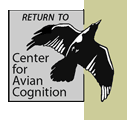


| Content Pages | ||
|
Spatial Memory Use of Landmarks |
||
|
|
||
| People | ||
| Russell P. Balda | ||
| Alan C. Kamil | ||
|
|
||
| Docs & Links | ||
|
Books Publications Links |
||
|
|
||
 |
||
 |
||
 |
Seed-caching and the Evolution of Spatial Memory
Many seed-eating birds, especially among the Corvidae (the crows and jays) and Paridae (tits and chickadees), store their food in caches to use at a later time. These birds must employ spatial memory to re-locate their stored food items. Clark's nutcrackers (Nucifraga columbiana) are an extreme case. Each nutcracker stores pine seeds at thousands of cache sites in the fall and remembers the locations for many months, often retrieving the seeds through a blanket of snow. This aspect of their natural history has made nutcrackers a central focus of our work on spatial cognition, a highly productive research program that was funded extensively by the National Institutes of Health and the National Science Foundation for nearly 20 years.
One of the central themes of this research lay in testing the hypothesis that species that cache and retrieve larger numbers of seeds should experience strong natural selection for increased persistence and capacity of spatial memory. In a series of experiments comparing Clark's nutcrackers to other New World, seed-caching corvids, we applied the "convergent operation" approach (Kuo 1970; Kamil 1987; Shettleworth 2009), testing for species differences in spatial memory along a number of different dimensions. Balda and Kamil (1989) found that nutcrackers and pinyon jays recovered caches better than western scrub jays, and Olson (1991) found that nutcrackers also performed better than western scrub jays or pigeons on a spatial memory task in which the birds were required to remember a location defined by a pecking key on the wall of an operant chamber. When the nutcracker lab was transferred to the Center for Avian Cognition, our most productive period of spatial cognition research began, starting with Kamil, Balda, and Olson's (1994) demonstration that nutcrackers performed better than either scrub jays or Mexican jays in an open-room analog of the radial-arm maze.
A crucial pair of experiments were carried out by Olson, Kamil, Balda and Nims (1995). In the first, the birds were simply required to remember the spatial position of a stimulus. We found that nutcrackers performed better than pinyon jays, scrub jays or Mexican jays on this task. In the second experiment, the same birds were tested on an identical nonspatial task, being required to remember the color of a stimulus rather than its location. This change in the nature of the information they had to remember completely changed the pattern of results. None of the species differences in the color memory task were statistically significant, but the pinyon jays performed best. These results are in strong agreement with the hypothesis that selection in seed-caching birds has favored spatial memory, rather than some more general memory ability. Several studies have shown that the ability of Clark's nutcrackers to find their cached food depended on the location of landmarks (e.g., Vander Wall 1981, Balda & Turek 1984). This, of course, raised the question of just how the birds use the position of a set of landmarks to recognize a cache location.
To understand how movements during caching were related to those during recovery, Kamil, Balda, and Good (1999) carried out a detailed analysis of caching and recovery behavior. Among the caching behaviors quantified were the time spent at each site and the number of times the birds probed with their beaks into the substrate, as well as the compass direction used to approach and leave the site. There was no evidence that any of these measures correlated with recovery accuracy. The birds recovered their caches very quickly and accurately even when approaching or probing the cache site from a completely different direction. Consistency of direction of approach was completely unrelated to recovery accuracy. Because the birds' view of the landmarks in the room varied with their direction of movement, this finding suggested that multiple, different relationships between cache locations and landmarks must have been used. This initiated an intensive, diversified investigation into the nutcrackers' use of landmarks in orientation.
References from Other Sources
Balda, R.P., & Kamil, A.C. (1989). A comparative study of cache recovery by three corvid species. Animal Behaviour 38: 486-495.
Balda, R.P., & Turek, R.J. (1984). The cache-recovery system as an example of memory capabilities in Clark's nutcrackers. In: H.L. Roitblat, T.G. Bever, and H.S. Terrace (Eds.), Animal Cognition. Hillsdale, NJ: Lawrence Erlbaum Assoc, pp. 513-532.
Kuo, Z.-Y. (1970). The need for coordinated efforts in developmental studies. In: L.R. Aronson, E. Tobach, D.S. Lehrman, & J.S. Rosenblatt(eds.), Development and Evolution of Behavior (pp. 181-193). San Francisco: Freeman Press.
Olson, D.J. (1991). Species differences in spatial memory among Clark's nutcrackers, scrub jays, and pigeons. Journal of Experimental Psychology: Animal Behavior Processes 17: 363-376.
Shettleworth, S.J. (2009). Cognition, Evolution, and Behavior, 2nd Ed. Oxford: Oxford U. Press.
Vander Wall, S.B. (1981). An experimental analysis of cache recovery in Clark's nutcracker. Animal Behaviour 30: 84-94.